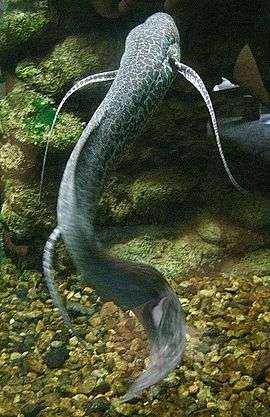Marbled lungfish
| Marbled lungfish | |
|---|---|
 | |
| Scientific classification | |
| Kingdom: | Animalia |
| Phylum: | Chordata |
| Subphylum: | Vertebrata |
| Class: | Sarcopterygii |
| Subclass: | Dipnoi |
| Order: | Lepidosireniformes |
| Family: | Protopteridae |
| Genus: | Protopterus |
| Species: | P. aethiopicus |
| Binomial name | |
| Protopterus aethiopicus Heckel, 1851[1] | |
| Subspecies | |
The marbled lungfish (Protopterus aethiopicus) is a lungfish of the family Protopteridae. Also known as the leopard lungfish, it is found in Africa. At 133 billion base pairs[2] it has the largest known genome of any vertebrate and one of the largest of any organism on Earth, along with Polychaos dubium and Paris japonica at 670 billion and 150 billion, respectively.
Description
The marbled lungfish is smooth, elongated, and cylindrical with deeply embedded scales. The tail is very long and has tapers at the end. They can reach a length of up to 2 m (6.6 ft).[1] The pectoral and pelvic fins are also very long and thin, almost spaghetti-like, used for gliding through the water. The newly hatched young have branched external gills much like those of newts. After two to three months, the young metamorphose into the adult form, losing their external gills for gill openings. These fish have a yellowish gray or pinkish-toned ground color with dark slate-gray splotches, creating a marbling or leopard effect over their bodies and fins. The color pattern is darker along the top and lighter below.[3]
Distribution
Protopterus aethiopicus is found in the African countries of Tanzania, Ethiopia, the Democratic Republic of Congo, Kenya, Uganda, and the Sudan. Specifically, it lives in the Nile River and in lakes such as Albert, Edward, Tanganyika, Victoria, Nabugabo, No, and Kyoga.[4] Different subspecies are found in different areas: P. a. aethiopicus lives in the Nile and lakes Victoria and Tanganyika, P. a. congicus in the middle and upper Congo River, and P. a. mesmaekersi in the lower Congo.[4]
Habitat
Adult marbled lungfish live in swamps, riverbeds, floodplains, and river deltas throughout its range.[4] The juvenile members of the species often live in between the roots of papyrus plants.[4] Despite being aquatic, adult marbled lungfish can live in riverbeds and other areas that have no rain for portions of the year due to their ability to estivate or burrow in the ground to form an air bubble and breathe out of a hole in the cocoon thus formed.[4]
Reproduction
Breeding generally occurs during flood season, during which time males prepare a pit nest.[4] One or more females may use the same pit nest, into which they lay their eggs.[4] The female(s) then leaves the nest and the male guards the nest from attack for the next 8 weeks; in addition, he regularly fills the nest with air to ensure that the newly-laid eggs survive.[4]
Diet
The diet of adults consists largely of mollusks, such as Mutela bourguignati.[4] They also eat small fishes and insects at times; the diet of juveniles consists almost entirely of insects.[4]
References
- 1 2 Fishbase.org
- ↑ IJ Leitch (13 June 2007). "Genome sizes through the ages". Heredity. Nature Publishing Group. 99 (2): 121–122. doi:10.1038/sj.hdy.6800981. ISSN 0018-067X.
- ↑ Animal-world.com
- 1 2 3 4 5 6 7 8 9 10 Fishbase.org
